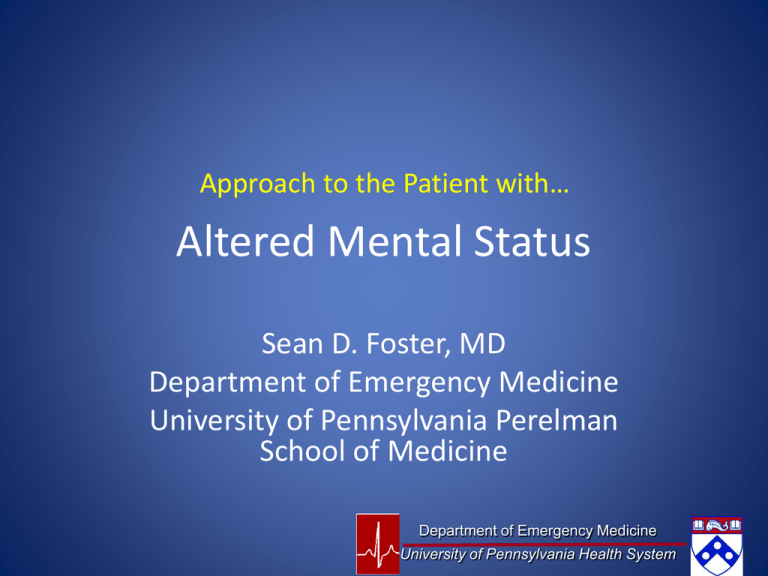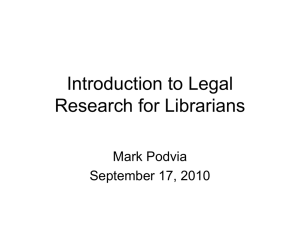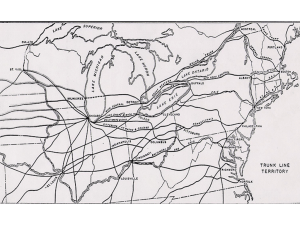Altered Mental Status - Penn Medicine
advertisement

Approach to the Patient with… Altered Mental Status Sean D. Foster, MD Department of Emergency Medicine University of Pennsylvania Perelman School of Medicine Department of Emergency Medicine University of Pennsylvania Health System Questions/Comments/Suggestions Sean.Foster@uphs.upenn.edu Department of Emergency Medicine University of Pennsylvania Health System Outline 1. Pathophysiology & Definitions (brief) 2. Approach to the “altered patient” 3. Case examples Department of Emergency Medicine University of Pennsylvania Health System Outline 1. Pathophysiology & Definitions (brief) 2. Approach to the “altered patient” 3. Case examples Department of Emergency Medicine University of Pennsylvania Health System Question for the audience: What is “Altered Mental Status”? • Symptom or diagnosis? • Change in Consciousness Acute (rarely subacute) What about this? Department of Emergency Medicine University of Pennsylvania Health System Consciousness 1. Alertness or arousal – “Level” 2. Content of consciousness – “Confusion” Department of Emergency Medicine University of Pennsylvania Health System 1. Level of Consciousness Terms • Minimally conscious state: – Inconsistent but discernable evidence of consciousness. Able to follow commands. • Obtundation: – awake but not alert, with psychomotor retardation • Stupor: – awakens with stimuli but little motor or verbal activity when aroused Department of Emergency Medicine University of Pennsylvania Health System Coma • Broadly defined as “a state of deep unconsciousness that lasts for a prolonged or indefinite period” • More specifically: complete failure of the arousal system with no spontaneous eye opening COMA: brainstem dysfunction and/or bilateral cortical disease Department of Emergency Medicine University of Pennsylvania Health System 2. Content of Consciousness • Alteration in higher cerebral functions – Memory, awareness or attention • Wide range of presentations: – Mild confusion to delirium A state of disturbed consciousness with associated: Motor restlessness Transient hallucinations Disorientation Delusions Department of Emergency Medicine University of Pennsylvania Health System 2. Content of Consciousness • Cause: Widespread cortical dysfunction 1. Substrate deficit 2. Neurotransmitter dysfunction 3. Circulatory dysfunction • Reserve of CNS function varies by individual Department of Emergency Medicine University of Pennsylvania Health System Common Classifications DELIRIUM DEMENTIA 1.Delirium PSYCHOSIS ONSET Rapid Slow Variable COURSE Fluctuating Progressive Variable VITALS Often Abnormal Normal Variable (Usually normal) PHYSICAL EXAM Often Abnormal Normal (usually) Normal (usually) HALLUCINATIONS Visual (External stimuli) Rare Auditory (Internal Stimuli) UNDERLYING CAUSE Organic (myriad) Organic (degenerative) Functional PROGNOSIS Poor (if cause not treated) Progressive Variable 2.Dementia 3.Psychosis Adapted from: CDEM Curriculum “The Approach to Altered Mental Status” Important points: 1. Focal cortical dysfunction does not usually cause confusion 2. Subcortical/brainstem dysfunction usually affects level of consciousness, rather than content Department of Emergency Medicine University of Pennsylvania Health System Outline 1. Pathophysiology (brief) 2. Approach to the “altered patient” 3. Case examples Department of Emergency Medicine University of Pennsylvania Health System A problem: Department of Emergency Medicine University of Pennsylvania Health System “Worst First” What are the immediately life threatening and/or reversible causes of altered mental status? Department of Emergency Medicine University of Pennsylvania Health System Immediate and/or rapidly reversible life threats • • • • • • • • • • Loss of airway Hypoxia Respiratory failure Narcotic overdose Hypotension/shock Dysrhythmia Intracranial catastrophe Major trauma Hypo/hyperthermia (Severe) Hypoglycemia A B C D E Vitals Glucose Department of Emergency Medicine University of Pennsylvania Health System EM Approach • • • • • • Airway Breathing Circulation Disability (neurologic) Exposure Finger stick glucose **Should occur as patient is placed on monitor/vitals obtained/IV access established ***Deal with issues as they are identified Department of Emergency Medicine University of Pennsylvania Health System Airway • How do you assess? • What do you look for? • What interventions can you make? Department of Emergency Medicine University of Pennsylvania Health System Airway: rapid differential • Loss of protective reflexes – Many causes… – Overdose – Intracranial catastrophe • Oropharyngeal swelling – Anaphylaxis – Angioedema – Infections • Ludwig’s angina, PTA • Stridor – Infection • RPA, epiglottitis, tracheitis, croup – Foreign body aspiration Breathing • How do you assess? – – – – – – Rate Depth Pattern Auscultation (bilateral and equal?) Pulse oximetry End Tidal CO2 • What options are there for interventions? – – – – – – Supplemental O2 Positive pressure support (CPAP, BiPAP) BVM Consider narcan if AMS + hypoventilation Intubation Decompression Department of Emergency Medicine University of Pennsylvania Health System Breathing: rapid differential • Hypoxia – pneumonia, CHF, PE, COPD • Respiratory depression – opioids, brainstem injury – Hypercarbia = “CO2 narcosis” • Tachypnea – Profound Met Acidosis Methanol/EG DKA/AKA Sepsis – Respiratory Stimulation Salicylates • Asymmetric exam – Pneumothorax, hemothorax – Large effusion Department of Emergency Medicine University of Pennsylvania Health System Circulation • How do you assess? – – – – Distal pulses Blood Pressure Cardiac rhythm Distal perfusion • What options are there for interventions? – – – – – IV fluids Blood products Cardioversion Cardiac pacing Inotropes/chronotropes/vasopressors Department of Emergency Medicine University of Pennsylvania Health System Circulation: rapid differential • Hypotension – Shock differential (distributive, neurogenic, obstructive, hypovolemic, cardiogenic) • Hypertension – Hypertensive crisis – Sympathomimetic abuse (cocaine, amphetamines, designer drugs) – Elevated ICP (mass lesion, hemorrhage) – Compensatory reflex (cushing’s, iscemic stroke) Department of Emergency Medicine University of Pennsylvania Health System Circulation (cont’d) • Tachycardia – Broad differential… • Bradycardia – – – – – – Drug overdose (BB, CCB, digoxin, lithium) Organophosphate exposure Uremic encephalopathy Hyperkalemia Myocardial ischemia (particularly in elderly) Neurogenic shock Department of Emergency Medicine University of Pennsylvania Health System Disability (neurologic catastrophe) • How do you assess? – – – – – GCS or AVPU Pupillary exam Look for seizure activity Evaluate extremity movement Signs of elevated ICP • What interventions can you make? – – – – Anti-epileptics Consider c-spine immobilization Elevate head of bed Hypertonic agents Department of Emergency Medicine University of Pennsylvania Health System Glascow Coma Score Department of Emergency Medicine University of Pennsylvania Health System AVPU • • • • Awake/Alert Voice Pain Unresponsive Department of Emergency Medicine University of Pennsylvania Health System Disability: rapid differential • Conjugate eye deviation – Stroke (toward lesion) – Seizure (away from lesion) • Hemiparesis – Stroke – Post-ictal state – ICH • Signs of elevated ICP – Mass lesions – Stroke with swelling – ICH Exposure • What does this mean? – Fully undress patient – Head to toe rapid exam • What are you looking for? – Trauma – Patches – Lines, tubes, fistulas – Rashes, wounds/decubitus ulcers Department of Emergency Medicine University of Pennsylvania Health System Don’t forget the fingerstick! Hypoglycemia • Causes? – Insulin/hypoglycemic drug overdose • New renal dysfunction • Accidental ingestion (Children) – Dietary changes – Sepsis (alcoholics, babies, elderly) • Treatment? – Childen (rule of 50) – Adult (1-2 amps D50) – All: Eat something! Department of Emergency Medicine University of Pennsylvania Health System HYPERglycemia • Can this cause AMS? – DKA – HHNK/HHS – Sepsis – Medication effect (steroids, CCB overdose) Now that you have treated life threatening emergencies and assessed for immediately reversible conditions….. Department of Emergency Medicine University of Pennsylvania Health System Still a problem: Department of Emergency Medicine University of Pennsylvania Health System • A (alcohol) • T (trauma, toxicology, tumor, temperature) • E (endocrinopathy, encephalopathy, electrolytes) • I (insulin, infection, increased intracranial pressure) • I (infection, inborn errors of metabolism) • P (psychiatric, postictal state) • O (opiates, oxygen) • S (seizure, stroke, shock, space• U (uremia) occupying lesions) Department of Emergency Medicine University of Pennsylvania Health System History, History, History! Diagnosis usually based on history! – Where can you get it? Collateral • • • • • EMS Family/friends Old charts Primary physician Medic alert bracelet Department of Emergency Medicine University of Pennsylvania Health System History • • • • • • • Baseline – be specific How often do they see the patient? What is the “change” they observed? Medical history Medications Social history ROS – any recent complaints? Department of Emergency Medicine University of Pennsylvania Health System Physical Exam • Complete physical exam always indicated – Look for stigmata of chronic disease – Signs of trauma – Evidence of toxidromes • Undress your patients (always) • Don’t forget the back exam Department of Emergency Medicine University of Pennsylvania Health System Vital & Physical Any abnormality should increase your suspicious for delirium Department of Emergency Medicine University of Pennsylvania Health System By the completion of the H&P, you should be able to: • Categorize as delirium, dementia, psychosis • Initiate a diagnostic evaluation Department of Emergency Medicine University of Pennsylvania Health System Differential diagnosis (treatable Causes) • A (alcohol) • E (endocrinopathy, encephalopathy, electrolytes) • I (insulin, infection, increased intracranial pressure) • O (opiates, oxygen) • U (uremia) • T (trauma, toxicology, tumor, temperature) • I (infection, inborn errors of metabolism) • P (psychiatric, post-ictal state) • S (seizure, stroke, shock, space-occupying lesions) Department of Emergency Medicine University of Pennsylvania Health System Differential diagnosis I: Infection - Sepsis, encephalitis, meningitis, syphilis, central nervous system (CNS) abscess, malaria W: Withdrawal - Alcohol, barbiturates, sedative-hypnotics A: Acute Metabolic and endocrine - Acidosis, electrolyte disturbance, hepatic or renal failure, magnesium, calcium, porphyria; endocrinopathies: diabetes, adrenal, thyroid T: Trauma – head trauma, burns, abuse C: CNS dz – Hemorrhage (EDH, SDH, SAH, intracerebral), stroke, vasculitis(TTP), seizures, tumor (benign, malignant primary vs metastatic) H: Hypoxia/Hypercarbia – chronic lung dz (ie COPD), acute (Pneumonia, CO, Methemoglobinemia), global hypoperfusion D: Deficiencies- Vitamin B12, hypovitaminosis, niacin, thiamine E: Environmental: Hypothermia, hyperthermia; A: Acute Vascular - Hypertensive emergency, subarachnoid hemorrhage, sagittal vein thrombosis T: Toxins/Drugs - Medications, street drugs, alcohol, pesticides, industrial poisons (e.g., carbon monoxide, cyanide, solvents), serotonin syndrome, NMS H: Heavy Metals - Lead, mercury, Iron Department of Emergency Medicine University of Pennsylvania Health System Outline 1. Pathophysiology & Definitions (brief) 2. Approach to the “altered patient” 3. Case examples Department of Emergency Medicine University of Pennsylvania Health System Case 22 yo M presenting with EMS after being found screaming at passersby in center city. He swung at a police officer and was tazed by police . He required restraints with EMS. He is thrashing violently and screaming “I am god”. He won’t answer your questions. What is your next step? Department of Emergency Medicine University of Pennsylvania Health System Important point: You are responsible for the safety of yourself, your team and your patient At times this may require restraining and/or sedating your patient even before completing your physical exam Department of Emergency Medicine University of Pennsylvania Health System Drug therapy for agitated patients Drug induced: Drug withdrawal: Psychiatric: Dementia: Unknown: Benzodiazepines Benzodiazepines Antipsychotic Antipsychotic Benzodiazepines • Lorazepam 1-2 mg IV • Midazolam 2.5-10 mg IM • haloperidol 2-5 mg IV => double the dose every 20-30 minutes prn Department of Emergency Medicine University of Pennsylvania Health System Agitated delirium • Association with illicit drug use – not universal. • Treat if: – Presence of excited delirium – Continued maximal struggle despite attempts at maximal restraint Department of Emergency Medicine University of Pennsylvania Health System Sudden Cardiac Death Mechanism unknown – No definite etiology usually found at autopsy – Catecholamine excess leading to stress cardiomyopathy vs profound metabolic acidosis likely leading to cardiac arrest? – Hyperthermia, seizures, hyperkalemia often contributory Department of Emergency Medicine University of Pennsylvania Health System Now he is calmer, what next? BP 180/100 HR 137 SpO2 100% RA T 99.8 RR 16 FSBG 100 Airway: intact Breathing: lungs clear, good effort Circulation: normal pulses x 4, tachycardic & hypertensive Disability: PERRL (Dilated), MAE. GCS 14 (4-4-6) Exposure: no rashes. Skin flushed, sweaty. No patches or wounds. Department of Emergency Medicine University of Pennsylvania Health System Detailed exam GEN: now drowsy but still awake HEENT: pupils bilaterally dilated, trace reactive. Mucous membranes moist CV: tachycardic, regular PULM: clear bilaterally ABD: unremarkable EXT: no trauma or swelling SKIN: diaphoretic, otherwise normal NEURO: GCS 14. CN 2-12 intact. Moving all extremities equal. Department of Emergency Medicine University of Pennsylvania Health System Differential Dx? • Toxic ingestion • Infection – Encephalitis – Meningitis • Psychiatric disease • Neuroleptic malignant syndrome • Serotonin syndrome Department of Emergency Medicine University of Pennsylvania Health System What else can you try? Does that explain his symptoms? Department of Emergency Medicine University of Pennsylvania Health System Four Classic Toxidromes Heart rate Oral Findings Blood pressure Mental status Eyes Skin Anticholinergic Tachy None Variable Delirium Mumbling Seizures Dilated Dry, flushed Warm-hot Sympathomimetic Tachy None High Delusional Paranoia Agitation Seizures Dilated Diaphoretic Piloerection Sedative Brady None Low lethargic Coma nonbreathing Constricted hypothermic Or Dilated Cholinergic Variable salivation Variable Confusion Seizure CNS depression Constricted Diaphoretic Workup • • • • EKG Basic Metabolic Panel Total CK UDS Department of Emergency Medicine University of Pennsylvania Health System Sympathomimetic Toxidrome: Treatment • Attempt to calm patient • Maintain safety of team and patient • Supportive Care – – – – Monitor airway IVF for insensible losses Benzodiazepines (IV or IM) for agitation or seizure EKG – Avoid Beta blockers Department of Emergency Medicine University of Pennsylvania Health System Questions? Department of Emergency Medicine University of Pennsylvania Health System Case A 75 year old female is transferred to the emergency department from a skilled nursing facility. She arrived last night after discharge from the hospital for a hip fracture. Overnight she began screaming that someone was “trying to kill her”, and insisted that her husband was looking for her, though he is known to be deceased. The facility is stating that her dementia was not adequately described prior to transfer, and that they cannot meet her level of care needs. EMS found her to be awake, pleasant and cooperative. Department of Emergency Medicine University of Pennsylvania Health System BP 146/82 HR 90 RR 16 SpO2 96%% T100.2 (O) FSBG: 132 • Airway: intact. Phonates easily. • Breathing: intact. Normal sats. Good bilateral air mvmt. • Circulation: intact: normotensive. Equal pulses. Good distal perfusion. • Disability: perrl, moves all extremities spontaneously. Alert. GCS 15 • Exposure: no skin lesions, patches, rashes Department of Emergency Medicine University of Pennsylvania Health System • • • • • GEN: thin elderly woman. Nontoxic. HEENT: atraumatic. PEERL. Sclera anicteric. NECK: supple, no jvd LUNGS: clear bilaterally CV: RRR ABD: soft, nontender • EXT: no edema, deformity or tenderness • SKIN: no rash • NEURO: slightly drowsy but awake. Oriented to person and place but not time. CN 2-12 intact. Normal strength and sensation. What else would you like to know? Department of Emergency Medicine University of Pennsylvania Health System Approximately 1 hour later, the nurse notifies you that the patient is becoming increasingly paranoid and is insisting that she is being held against her will. What is the diagnosis? Department of Emergency Medicine University of Pennsylvania Health System Delirium Department of Emergency Medicine University of Pennsylvania Health System Delirium vs Dementia – – – – – Delirium Fluctuating course of confusion Acute onset Reversible cause Difficult to distinguish from acute psychosis Depressed level and content of consciousness – – – – Dementia Stable course of confusion Insidious onset Irreversible and slowly progressive No impairment of level of consciousness Delirium always has an organic cause Differential diagnosis? • Drug effect (most common overall) • Infectious process – UTI (!!!) – Pneumonia – Bacteremia – Skin and soft tissue infection (bed sores?) • CNS process – ICH, Subdural • Acute MI Department of Emergency Medicine University of Pennsylvania Health System Meds to watch for • • • • • • • Narcotics Benzodiazepines antibiotics anticholinergic drugs antiepileptics anti-inflammatory agents (corticosteroids) cardiovascular medications (beta-blockers, antidysrhythmics, antihypertensives, cardiac glycosides) • sympathomimetics • Psychiatric medications (antidepressants, antipsychotics, mood stabilizers) Department of Emergency Medicine University of Pennsylvania Health System Managing Delirium • minimize sensory overload – limit the number of care-givers – quiet environment – Try to maintain day/night cycle if possible • allow family members to remain in constant/frequent attendance • do not leave patients unattended • ensure that the bed side-rails are up Department of Emergency Medicine University of Pennsylvania Health System Drug therapy for agitated patients Drug induced: Drug withdrawal: Psychiatric: Dementia: Unknown: Benzodiazepines Benzodiazepines Antipsychotic Antipsychotic benzodiazepines • Lorazepam 1-2 mg IV • Midazolam 2.5-5 mg IM • haloperidol 2-5 mg IV => double the dose every 20-30 minutes prn Department of Emergency Medicine University of Pennsylvania Health System Questions? Department of Emergency Medicine University of Pennsylvania Health System Case An 80 year old female is brought by EMS from the nursing home with concern for altered mental status. She was found “babbling nonsensically” in her room this morning. When you address her, she appears to regard you but doesn’t answer questions appropriately, instead making nonsensical strings of words. What is the next step of your evaluation? Department of Emergency Medicine University of Pennsylvania Health System BP 175/100 HR 80 RR 14 SpO2 99% T 98.2 FSBG 98 • Airway: intact. Phonates. Handling secretions. • Breathing: intact. Good sats, good bilateral air movement • Circulation: intact. Hypertensive but equal pulses and good distal perfusion. • Disability: GCS 13 (4-3-6). Gaze preference to the left. PERRL. Follows commands with R side. • Exposure: no rashes, skin lesions, patches Department of Emergency Medicine University of Pennsylvania Health System GEN: awake, alert. HEENT: atraumatic. PERRL. Eyes deviated to the L side. PULM: clear bilaterally CV: regular rate and rhythm, no murmurs ABD: soft, nontender EXT: no swelling SKIN: no rash or lesions NEURO: awake, alert. CN exam reveals mild facial asymmetry with loss of nasal fold on R. gaze preference to the L. Strength decreased (3/5) on testing of RUE in all areas. Mildly decreased (4+/5) in RLE. What else would you like to test? Department of Emergency Medicine University of Pennsylvania Health System Differential Diagnosis Is this person experiencing “Altered Mental Status?” • • • • Ischemic Stroke Hemorrhagic stroke Complex partial seizure CNS mass lesion Department of Emergency Medicine University of Pennsylvania Health System What workup would you initiate? • • • • • • • • CT Head EKG Basic Metabolic Panel CBC Coags Chest XRAY Urinalysis Troponin (?) Department of Emergency Medicine University of Pennsylvania Health System Take home points • Generally speaking, stroke should not produce “altered mental status” • Focal neurologic deficits may mimic altered mental status – Aphasias, hemisensory neglect, cortical blindnes • A detailed neurologic assessment is always indicated Department of Emergency Medicine University of Pennsylvania Health System Questions? Department of Emergency Medicine University of Pennsylvania Health System Case 19 yo F brought by friends from her dormitory stating that she isn’t “acting right”. They report that she was complaining of fatigue and malaise yesterday, and this morning of a headache. Nobody had seen her since breakfast and when they found her she was confused. What would you like to do next? Department of Emergency Medicine University of Pennsylvania Health System BP 95/50 HR 120 RR 22 T 102.2 SpO2 99% RA • Airway: intact • Breathing: mildy tachypneic, good sats, lungs clear • Circulation: mildly hypotensive but bounding pulses x 4, well perfused digits. • Disability: Opens eyes, moans and grabs your hand to painful stimulus (GCS?). PERRL CN intact, moves all extremities equally • Exposure: scattered petechiae and purpura on extremities. Diaphoretic. Department of Emergency Medicine University of Pennsylvania Health System Differential Dx: • Sepsis – Meningitis – Encephalitis • Toxic ingestion • Heat stroke • NMS/SS What do you do next? Department of Emergency Medicine University of Pennsylvania Health System GEN: lethargic, responds to painful stimuli by opening eyes,moaning and grabbing your hand HEENT: PERRL. Oropharnyx unremarkable aside from dry mucous membranes CV: tachycardic, regular PULM: clear bilaterally ABD: unremarkable EXT: no trauma or swelling SKIN: diaphoretic NEURO: CN 2-12 intact. Moving all extremities equal. What other exam information do you want? Meningitis Treatment • Various algorithms exist • Options include: 1. Empiric BS Abx, followed by CT head/LP 2. Immediate LP followed by empiric abx • Largely depends upon degree of suspicion, risk factors for elevated ICP/mass lesions Department of Emergency Medicine University of Pennsylvania Health System Meningitis Treatment **Role of steroids (Dexamethasone) unclear. If giving, give before or concurrently with abx Questions? Department of Emergency Medicine University of Pennsylvania Health System Case 35 yo F found by passersby unresponsive and apneic. Brought by EMS with active bagging en route. No ID or collateral information present. What do you do next? Department of Emergency Medicine University of Pennsylvania Health System BP 118/72 HR 50 T 98.0 (R) RR 0 SpO2 95% BVM (100% O2) FSBG 110 • Airway: no gag, sonorous with bagging • Breathing: no spontaneous respirations • Circulation: normotensive, mildly bradycardic. All extremities appear cyanotic. What next, doctor? Show of hands: 1. Intubate now 2. Finish rapid initial assessment, then decide how to proceed 3. Administer antidote to her overdose Department of Emergency Medicine University of Pennsylvania Health System Keeping going… • Disability: pupils <1mm bilaterally. GCS 3. • Exposure: Now what? Department of Emergency Medicine University of Pennsylvania Health System Naloxone • Pure opioid antagonist • Routes: IV, IM, IN, Subcutaneous • Dose: 0.4-2mg (generally) – double q2-3 minutes until desired effect • Onset: <1 minute (IV). 1-2 minutes (Other) • Half life: ~30-60 min Department of Emergency Medicine University of Pennsylvania Health System Naloxone • What is the indication for administration? – Insufficient respiratory drive • What is the target when administering? – Sufficient respiratory drive – NOT normalization of mental status Department of Emergency Medicine University of Pennsylvania Health System Naloxone side effects • Common: – Dysphoria, nausea, pain (withdrawal symptoms) • Uncommon (but real) – Pulmonary edema – Seizure – Dysrhythmias Biggest problem: it wears off before the opiate agent does Department of Emergency Medicine University of Pennsylvania Health System Coming soon to a heroin user near you! Questions? Department of Emergency Medicine University of Pennsylvania Health System Case 60 yo F brought by EMS after witnessed seizure activity in a restaurant. Per EMS, lasted 3-4 minutes and resolved spontaneously. There was reported tonic-clonic activity. Per family, she has a known seizure history. She has been unresponsive since the event, which was approximately 20 minutes ago. Department of Emergency Medicine University of Pennsylvania Health System BP 142/72 HR 105T 99.1 (R) RR 18 SpO2 96% RA • Airway: snoring respirations; handling secretions • Breathing: adequate rate. Good air movement • Circulation: normotensive, good pulses and distal perfusion • Disability: eyes open but unresponsive to pain. Doesn’t follow commands. Nonspecifically withdraws L arm and leg to pain. GCS 9 (4-1-4) • Exposure: no rashes, wounds, patches, lesions What next, doctor? Department of Emergency Medicine University of Pennsylvania Health System FSBG: 110 Department of Emergency Medicine University of Pennsylvania Health System • • • • • • • • • GEN: eyes open but unresponsive to pain HEENT: Eyes deviated to L. PERRL. NECK: Ranges easily LUNGS: Clear CV: mildy tachy, regular, no murmers ABD: soft, nondistended EXT: no edema, no deformity SKIN: no rash NEURO: groans to pain. GCS is 4-1-4. doesn’t participate in exam. What else would you like to know? Department of Emergency Medicine University of Pennsylvania Health System Differential Dx • Post-ictal state • Status epilepticus (complex partial status) • Stroke – Hemorrhagic – Ischemic • Encephalitis Department of Emergency Medicine University of Pennsylvania Health System Workup • Head CT • Electrolytes • Level her AEDs • Trial of treatment (first line?) – Benzodiazepines • Obtain stat EEG Department of Emergency Medicine University of Pennsylvania Health System Seizures/Status Epilepticus • Post-ictal state common – Should rarely last longer than 20-30 minutes – Should progressively improve • Persistent neurologic deficits possible (todd’s paralysis), but should raise suspicion for alternative diagnosis or ongoing epileptic activity • Complex partial status epilepticus (aka nonconvulsive status) is often missed Department of Emergency Medicine University of Pennsylvania Health System Questions? Department of Emergency Medicine University of Pennsylvania Health System Case Police bring a 30 year old male directly from the scene of a two car MVC. He was the unrestrained driver and hit a parked car at high speeds. They state that he smells of alcohol. He is actively being restrained and is thrashing violently. He is speaking incoherently and not following your commands. Department of Emergency Medicine University of Pennsylvania Health System What do you do next? Department of Emergency Medicine University of Pennsylvania Health System BP 75/40 HR 155 RR 24 SpO2 95% RA T96.0 (R) • Airway: protecting (For now). Phonating. • Breathing: equal bilateral. • Circulation: weak distal pulses x 4. poor capillary refill. • Disability: PERRL, GCS 12 (4-3-5), moves all extremities • Exposure: bruising to scalp. Abrasions to abdomen and R chest wall. What next? Department of Emergency Medicine University of Pennsylvania Health System Department of Emergency Medicine University of Pennsylvania Health System BP 75/40 HR 155 RR 24 SpO2 95% RA T96.0 (R) • Airway: protecting (For now). Phonating. • Breathing: equal bilateral. • Circulation: weak distal pulses x 4. poor capillary refill. • Disability: PERRL, GCS 12 (4-3-5), moves all extremities • Exposure: bruising to scalp. Abrasions to abdomen and R chest wall. Department of Emergency Medicine University of Pennsylvania Health System Important Point Maintain a high index of suspicion for hypotension, hypoxia or intracranial abnormalities as cause of agitation in the trauma patient. Department of Emergency Medicine University of Pennsylvania Health System Questions? Department of Emergency Medicine University of Pennsylvania Health System Case A 20 year old male is brought by his concerned college roommates for altered mental status. They state that he is behaving erratically and seems delusional. They report 2 weeks of progressively increased agitation and for the last week he has been heard up all night in his room talking to himself. He hasn’t bathed himself either, stating “there’s no time”. Department of Emergency Medicine University of Pennsylvania Health System BP 122/72 HR 92 RR 14 SpO2 100% T 98.4 FSBG 101 • Airway: intact. Phonating easily • Breathing: good aeration bilaterally. Normal rate, normal sat • Circulation: normotensive, good pulses and perfusion • Disability: PERRL. GCS 15. Ambulates easily • Exposure: No rashes, patches, wounds Department of Emergency Medicine University of Pennsylvania Health System • GEN: slightly disheveled, awake, alert. Talkative and pacing around the room. • HEENT: atraumatic. Perrl. Oropharynx normal • NECK: ranges easily, no tenderness • LUNGS: clear bilaterally • CV: regular rate and rhythm, no murmers • ABD: soft, nontender • EXT: no swelling • SKIN: no rash • NEURO: alert, oriented x 3. CN intact. Normal strength and sensation. What else would you like to know? • Psych: – – – – Poorly kempt. Clothes brightly colored, mismatched slightly agitated with pressured speech. Thinking is disorganized and tangential. Demonstrates grandiosity (States “I’m going to call the president if you don’t release me!”). – Appears to be responding to internal stimuli but doesn’t acknowledge hearing voices when asked. – Denies suicidality (laughs, states he is too important for that) or homicidality. Department of Emergency Medicine University of Pennsylvania Health System Differential Diagnosis? • Psychosis (acute psychotic break) – Schizophrenia – Bipolar disorder • Drug induced psychosis – Bath salts – Stimulants Department of Emergency Medicine University of Pennsylvania Health System Organic Vs Functional: Organic Functional (Psychiatric) History History Acute onset Onset over weeks to months Any age Onset ages 12 to 40 years Mental status examination Mental status examination Fluctuating level of consciousness Alert Disoriented Oriented Attention disturbances Agitated, anxious Poor recent memory Poor immediate memory Hallucinations: visual, tactile, auditory Hallucinations: most commonly auditory Cognitive changes Delusions, illusions Physical examination Physical examination Abnormal vital signs Normal vital signs Nystagmus No nystagmus Focal neurologic signs Purposeful movement Signs of trauma No signs of trauma Management • • • • Assess willingness to obtain care Assess need for involuntary hold (“302”) Trial anti-psychotic if needed No medical testing absolutely necessary – Psychiatrists may request certain testing as “screen” – UDS, CBC, BMP Department of Emergency Medicine University of Pennsylvania Health System Questions? Department of Emergency Medicine University of Pennsylvania Health System Confusion in the ED: Take Home Pearls • Delirium always has an organic etiology • History from sources other than the patient may be critical and life saving • Obtain a full set of vital signs and thorough exam on all patients (especially those with AMS) • ED evaluation of AMS always follows the ABCDE approach Department of Emergency Medicine University of Pennsylvania Health System Questions/Comments/Suggestions Sean.Foster@uphs.upenn.edu Department of Emergency Medicine University of Pennsylvania Health System






